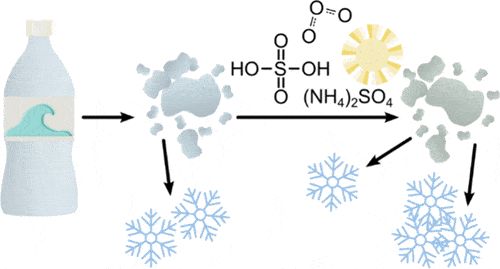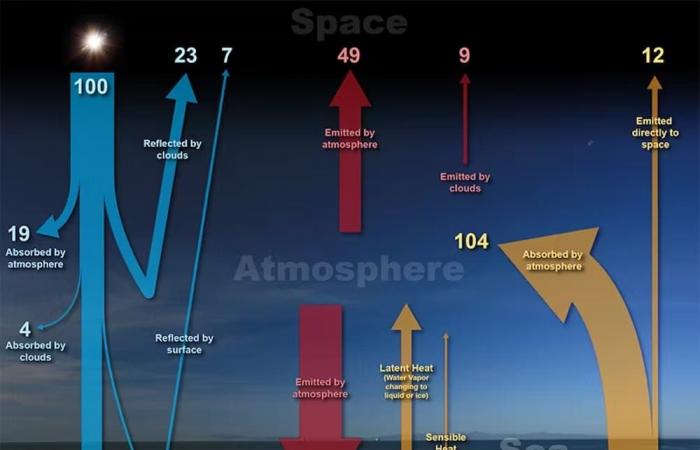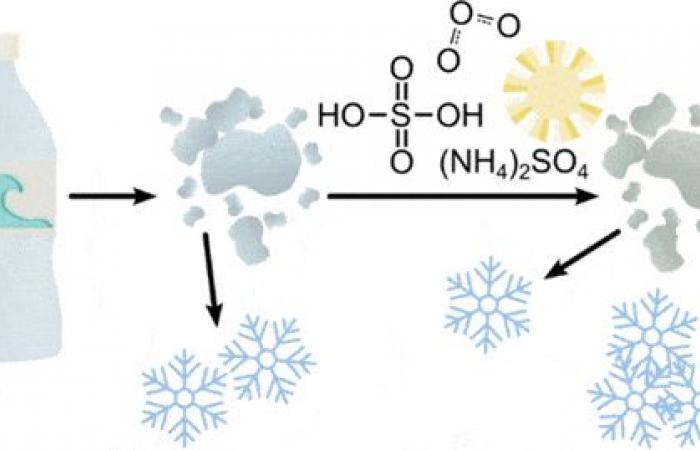⇧ [VIDÉO] You might also like this partner content
Study finds microplastics accumulating in the atmosphere could impact precipitation patterns and climate. These particles would promote the formation of ice crystals around which rain droplets accumulate. This suggests that they could induce the formation of clouds in conditions where they would not normally form and influence their ability to produce rain and reflect sunlight.
Microplastics are now ubiquitous in our environment, including places considered to be the purest and most inaccessible on the planet, such as the summit of Everest, the deep seas of Antarctica and the Mariana Trench. They have also been detected in our body with worrying concentrations in our brain and even the placenta, as well as in most living organisms.
A subset of microplastics with diameters less than 100 micrometers can be carried high in the atmosphere. The latter have, for example, been detected in clouds on mountain tops in China and Japan. Studies have suggested that the rate of atmospheric deposition of microplastics could exceed 10 milligrams per day per square meter.
The T-Shirt that breathes:
Display a powerful climate message ????
As part of the new study, detailed in the journal
Environnemental Science & Technology Airresearchers at Pennsylvania State University (Penn State) show that the presence of these particles in the atmosphere can have an impact on weather conditions and climate. Like all solid atmospheric particles, they would influence cloud formation and, by extension, precipitation patterns as well as climate forecasts — not to mention aviation safety.
« Over the past two decades of research into microplastics, scientists have found that they are everywhere. So this is a new piece of the puzzle. “, explains Miriam Freedman, co-lead author of the new study, in a Penn State press release. “ It is now clear that we need to better understand how they interact with our climate system, as we have been able to show that the process of cloud formation can be triggered by microplastics ».
Increased formation of ice crystals in clouds
In most temperate areas of the planet, the tops of many clouds are high enough that they reach the part of the atmosphere where cold air freezes some of the water they contain. The ice crystals formed then absorb the surrounding water vapor, forming liquid droplets that eventually fall as they become heavier. Called nucleation, this process prevents clouds from evaporating and producing rain or snow.
While water is generally thought to freeze at 0°C, ice crystals can form at much lower temperatures without a solid particle to nucleate around (dust, pollen, bacteria, etc.). Solid particles provide a nucleation surface from which crystals can form and water completely free of solid particles freezes at -38°C. “ If microplastics are present, they could cause ice crystals to form, which could increase rain or snowfall “, suggest the researchers of the new study in an article published in The Conversation.
On the other hand, the amount of sunlight reflected by clouds depends on the proportion of liquid water and ice they contain. They reflect incident sunlight back into space, which has a cooling effect. Those at low altitude, however, absorb part of the radiation emitted by the Earth’s surface, which has a warming effect. The team believes that if microplastics promote the nucleation of ice crystals, this could change the ability of clouds to scatter light and support the planet’s energy balance.
The Earth constantly receives energy from the Sun and radiates it back into space. Clouds have both a warming and cooling effect in this process. © NOAA
More frequent torrential rains?
To explore their hypothesis, the Penn State team evaluated the freezing points of water droplets contaminated with different types of microplastics, including low-density polyethylene (LDPE), polypropylene (PP), polyvinyl chloride (PVC ) and polyethylene terephthalate (PET). They found that the average freezing temperature was 5 to 10 degrees higher than those of water drops without microplastics. 50% of the droplets froze at -20°C for most of the microplastics studied. “ It turns out that if you introduce something insoluble, you introduce a defect in that droplet and it can nucleate ice at warmer temperatures “, explains Heidi Busse, lead author of the research.
See also


Although the exact implications of these particles are currently unclear, researchers believe they could increase the frequency of torrential rains. In an atmosphere containing a lot of aerosol, the available water would accumulate more around the particles. This should technically reduce the frequency of precipitation, “but because the droplets only fall once they are large enough, you collect more total water in the cloud before the droplets are large enough to fall and, therefore , you get heavier precipitation when it comes,” Freedman believes.


Schematic representation of the experimental protocol of the study. © Heidi L. Busse et al.
An impact conditioned by environmental aging
The researchers further suggest that environmental aging, a photochemical degradation that aerosol particles experience over time, can significantly change how particles interact with gases and vapors in the atmosphere. The team simulated the environmental aging of the 4 microplastics by exposing them to light, ozone and acids commonly present in the atmosphere.
All particles tested were able to nucleate ice. However, environmental aging reduced the nucleation capacity of LDPE, PP, and PET. On the other hand, it increased the nucleation capacity of PVC, probably due to slight changes in its structure. The team soon plans to study how additives commonly used for plastics could also influence this nucleation capacity.









